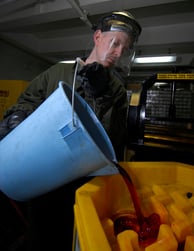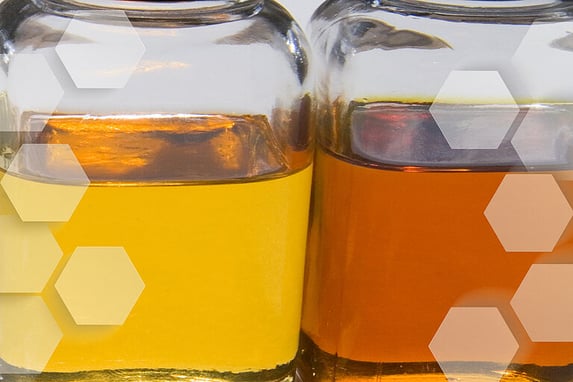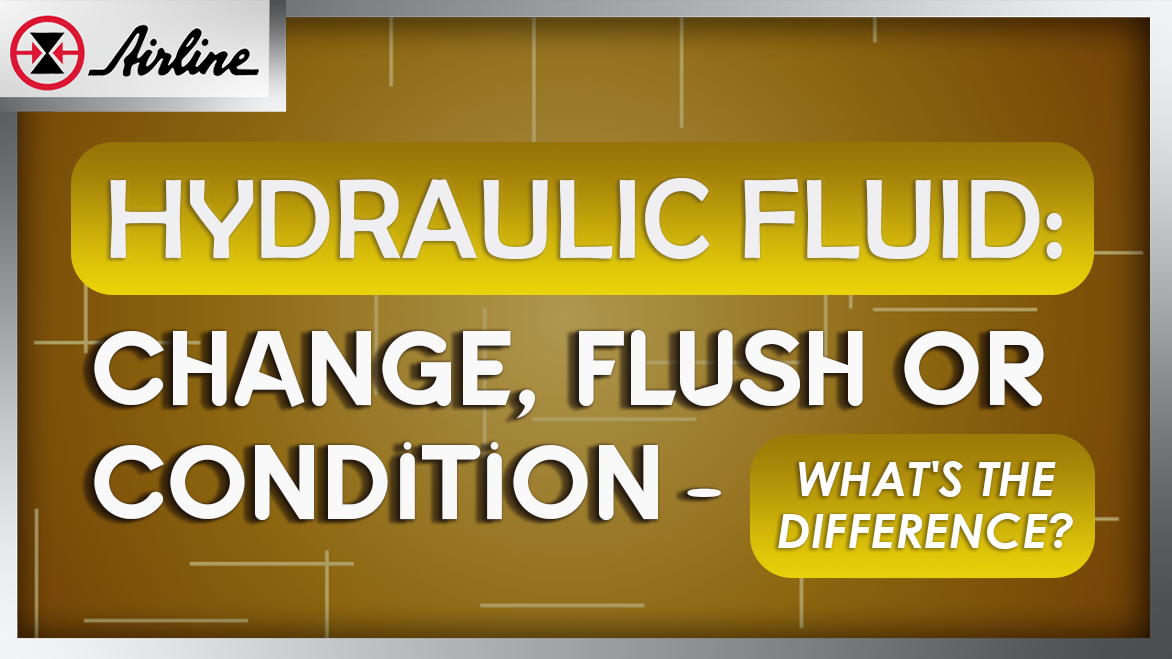Consider this: Your hydraulic equipment acts like the heart of your operation, essential for keeping your heavy machinery operational by circulating hydraulic fluid. This fluid not only powers your equipment but also plays a crucial role in maintaining smooth operation, making sure all parts function correctly. But over time, just like the heart's arteries can suffer from wear and tear, your hydraulic fluid can begin to show its age. Temperature changes, moisture, and unwanted particles can silently harm your system, causing it to age faster and weaken. This is where the average hydraulic equipment user asks – should I change my fluid, flush it, or condition it? In this blog post, we will dive into the differences between these methods and help you determine which one is best for your hydraulic system's needs.
Jump to a Section
The Importance of Regular Maintenance | Changing Hydraulic Fluid — When and Why? | Flushing Hydraulic Systems — The Hydraulic System Deep Clean | The Case for Conditioning Your Hydraulic Oil | When To Do a Hydraulic Oil Change, Flush, or Conditioning | Learn More In Our Webinar | Frequently Asked Questions | Resources
Register for the Hydraulic Varnish Mitigation 101 Webinar
Key Takeaways✅ To change your hydraulic fluid, drain the old fluid and replace it with new, fresh fluid.✅ To flush your hydraulic system means to clean out the entire system, including all hoses, valves, and reservoirs. This process is often done using a flushing fluid that removes any leftover contaminants from the old fluid. ✅ Conditioning hydraulic oil means treating the existing fluid with additives or filtration to improve its performance and extend its lifespan. ✅ Airline offers fluid cleanliness programs and conditioning units to help users achieve and maintain the required ISO cleanliness levels for their hydraulic systems. ✅ Join our webinar to learn more about the importance of hydraulic fluid maintenance and varnish mitigation. |
The Importance of Regular Maintenance
Before delving into the differences between changing, flushing, and conditioning hydraulic fluid, it's crucial to emphasize the importance of regular maintenance for hydraulic equipment. As mentioned earlier, contaminated or aged fluid can reduce performance and increase wear and tear on system components. This not only affects the equipment's productivity but also leads to expensive repair costs in the long run. Therefore, it is essential to follow manufacturer recommendations for fluid change intervals and regularly monitor the condition of your hydraulic oil.
🔧 Learn More about Hydraulic & Fluid Power Maintenance Solutions
Changing Hydraulic Fluid — When and Why?
A straightforward hydraulic oil change involves draining the old oil and introducing new oil. Although replacing hydraulic fluid may sound simple, the implications for your machine's health are significant by maintaining the very essence of your system’s efficiency and integrity of its moving parts.

When do you need new hydraulic oil? When your hydraulic system shows major signs of degradation— or the hydraulic fluid chemical composition differs from new fluid —it may be time to revitalize it with a change. Also, if you experience significant fluctuations in your hydraulic system’s temperature or observe a spike in contaminants such as dirt and water particles, these indicate that it's time for a fluid change. However, hydraulic fluid is expensive, but water and particle removal elements, applied efficiently, can reduce the need for a complete change. A consideration should be made to calculate the cost of reconditioning vs changing the hydraulic fluid.
Additionally, an oil change is recommended when the manufacturer specifies regular intervals based on equipment usage. Following the manufacturer's guidelines is important to ensure optimal hydraulic system performance.
Regular hydraulic fluid analysis acts as a preemptive check-up, ensuring that changes happen not too soon or too late. Considering variables like system usage, operating temperatures, and environmental conditions, a tailor-made schedule to change hydraulic oil can keep operations in peak condition. Learn more about our fluid cleanliness solutions.
Flushing Hydraulic Systems — The Hydraulic System Deep Clean
Sometimes, a simple hydraulic oil change isn't enough. Particularly in cases of major hydraulic failures or when introducing a different type of hydraulic fluid, a complete hydraulic flush becomes necessary.
Flushing goes beyond changing hydraulic oil. It addresses not only the old fluid but also entrenched contaminants in the entire system and hydraulic components—whether they be particulates, water, air, or varnish. It's like detoxifying your machinery's circulatory system.
As oil degrades, contaminants can build up in tight spots, such as hydraulic cylinders, hoses, return lines, and valves, diminishing the new fluid's performance. This leads to increased wear on parts and inefficient operation. By using a specialized flushing fluid, technicians can effectively clean out the entire system and ensure that the new oil performs at its best.
Consider, for instance, the accumulation of varnish—a stubborn residue of oxidized hydraulic oil that begins as a seemingly innocuous thin layer and can eventually wreak havoc, from narrowing lubrication gaps to impairing heat exchange. Conducting a hydraulic flush ensures that incoming oil isn't immediately contaminated by remnants from the original oil, thus extending the service life and promoting optimal performance.

The main cause of varnish formation is oxidation—the reaction between oil and oxygen in the air.
The Case for Conditioning Your Hydraulic Oil
![]() But what if you could rejuvenate your hydraulic fluid on the fly rather than changing or flushing it? This is where conditioning solutions stand out. Conditioning not only filters contaminants but also manages water content, air, and the oil's integrity, resulting in increased equipment availability and optimized component lifespan.
But what if you could rejuvenate your hydraulic fluid on the fly rather than changing or flushing it? This is where conditioning solutions stand out. Conditioning not only filters contaminants but also manages water content, air, and the oil's integrity, resulting in increased equipment availability and optimized component lifespan.
This method involves using specialized filtration products to improve the performance of existing fluid. There's a range of fluid conditioning products that can condition hydraulic oil by removing water and air, stabilizing viscosity, lowering the total acid number (TAN), and preventing varnish formation.
Cost savings are not a mere possibility but a substantial probability. For example, with HYDAC’s conditioning systems, you can potentially avoid up to 90% of fluid-related costs. This is about extending oil change intervals and reducing the life cycle cost, which is a win-win for both your bottom line and environmental sustainability.
🌟Shop Fluid Conditioning & Filtration
When To Do a Hydraulic Oil Change, Flush, or Conditioning
![]() To return to our original question of when to opt for a change, flush, or conditioning, it's key to have a comprehensive understanding of your hydraulic system and the hydraulic oil used. Due to their operating conditions, some systems may need more frequent flushing, while others may benefit from regular conditioning. Ultimately, the decision should be based on a combination of factors such as equipment usage and manufacturer recommendations.
To return to our original question of when to opt for a change, flush, or conditioning, it's key to have a comprehensive understanding of your hydraulic system and the hydraulic oil used. Due to their operating conditions, some systems may need more frequent flushing, while others may benefit from regular conditioning. Ultimately, the decision should be based on a combination of factors such as equipment usage and manufacturer recommendations.
Another key tool in your arsenal is regular and precise oil analysis. The resulting reports provide insight into your hydraulic system's specific needs. Contaminants—be they solid, liquid, gaseous, or gel-like—have different effects, ranging from abrasive wear to cavitation damage.
Identifying the type and extent of contamination is key. For example, fresh equipment, machines transitioning to different fluid types, or systems recovering from failure are prime candidates for a thorough flush. Meanwhile, routine changes and proactive conditioning strategies can maintain system health over the long term.
If you are still unsure of the best path, contact a field service expert, like Airline, to evaluate your unit. They can assess your oil sample and help you develop a maintenance plan that considers your hydraulic system's specific needs. By regularly monitoring and addressing the condition of your hydraulic fluid, you can ensure optimal performance and an extended lifespan for your equipment.
Join us for our upcoming webinar, Hydraulic Varnish Mitigation 101, on varnish removal to learn how to keep your systems clean from harmful contaminants. With expertise from Airline Hydraulics and HYDAC, you'll gain insights into effectively maintaining hydraulic fluids. Register Today!
Resources
- Shop Filtration & Fluid Conditioning
- Fluid Cleanliness Solutions
- Removing varnish in hydraulic oils efficiently - HYDAC
- 6 Types of Hydraulic Fluid Contamination You Need to Know
- More Hydraulic Blog Posts








Leave Comment